
Fun with an element of danger — that’s a forest run in a vintage Land Rover.
On Saturday afternoon, I got separated from the other 20 Rovers in my Caravan. I came to a fork in the road and had to make a decision. I made the wrong one.
Every year, the Pacific Coast Rover Club hosts a Christmas tour in Tillamook Forest. We meet in Banks, which is 25 miles west of Portland, OR, on State Highway 6.
It’s a low-intensity run, although all-terrain tires, front-and-rear tow-hook attachment points and a winch are recommended.
This year more than 20 rigs showed up, from a 1957 Series 1 pickup in delightfully original condition to a 2009 LR3.
I was impressed. Few vintage car clubs can get 20 vehicles out for an event. And this run on dirt logging roads carved out of the hillsides meant that paint scratches were expected — and a few dents and scrapes would not be unusual.
I like vintage Rover runs, as they are the ultimate vintage car experience. We are driving on the same trails that we might have used in the ‘50s and ‘60s. The trails are cut narrow, so modern Hummers and GM and Ford pickups simply can’t fit on them.
There are no guardrails. It’s a several-thousand-foot drop if you make an error.
The SCM D90 is a weapons-grade vehicle — a 1984 200 TDI that was imported from England after some participation in off-road events there. (At least that’s what we infer from the faded “1999 Warn Challenge” stickers on the doors.)
It’s a total bitsa, with a replacement frame, engine, gearbox, brakes and suspension. Portland’s Rover guru, Doug Shipman of Ship’s Mechanical, has installed an ARB air-locker for the rear and rebuilt the injection pump. It took about three years to get the D90 fully sorted and reliable — about the same as any vintage vehicle.
Now it rocks.
I love climbing up into the aftermarket Cobra competition seats and buckling the four-point harnesses. On the road, when you’re in compound second low, once you get just off of idle and the turbo starts to engage, the rig feels like it could crawl up a vertical wall.
My navigator was SCMer Dean Koehler, a retired Navy fighter pilot and Volvo aficionado (he has an 1800 coupe and an ES estate wagon). Aside from an occasional, “Do you need to be that close to the edge of the trail,” comment he seemed relatively composed.
We had an entertaining morning. The first trail was exceptionally steep and one rig fell completely off the road, requiring the services of two winches to pull it back on. Another rig shattered both its front axles. Doug removed them, and the owner motored home in RWD.
On a very steep trail, we ended up winching two more rigs up the hill. One needed help because it had started to fall down the hill off the road. The other was struggling because the open diff on the Series IIA rig just let it keep spinning its wheels.
After lunch, we motored up and down a challenging stretch called “Hogsback.” I’ve been fooling around on this stretch for nearly 10 years, first in our Range Rover Classic, then our Disco, then in our Series III and now our D90. The turbo diesel, rear locker and generous suspension travel make it a breeze.
Dean and I went up and down a few times without any drama.
However, the last time we came down all of the other rigs were gone. They had taken off without us.
They had broken rule number one of off-road convoys. When you’re in a group and you come to a “Y” in the road or a place to make a turn, never make that turn until you see the person following you in your mirror. That way you let them know which way the group is going.
There were three possible ways to reach the bottom of the hill.
We were hoping to catch up with the group, so picked one and took it.
While our fellow Land Rover fans made a mistake to leave us, we also made a mistake by not waiting 15 or 20 minutes for someone to come back for us.
We couldn’t reach anyone on our CB, there was no cell service and we didn’t have a ham radio.
We hustled off, hoping to catch the group. By the time it was clear we had picked the wrong road, doubling back would have been an exercise in folly. Chasing around forest logging roads with no way of knowing where anyone else is a waste of time at best — and it’s dangerous at worst if you are lost and the sun goes down.
We worked our way back to Highway 6 and headed back to Portland.
At the Rover dinner that night, we learned that only minutes after the group had set off, they realized we weren’t with them. They spread out and started looking for us. Their primary concern was that we had broken down or fallen off the road, and they wanted to find us.
There are hundreds of miles of winding, unmarked dirt roads in this forest. There are many cases of off-roaders getting stranded and suffering through cold and wet nights while waiting to be rescued.
If we had simply sat still for a few minutes, they would have found us.
In this case, there was no harm done. The weather was good, it was mid-afternoon and we were out of the forest before dark.
But there’s a lesson here for all of us. If you are on any kind of run and get separated from your group, just stop. Don’t go anywhere. Wait at least 15 minutes to see if someone comes back for you.
That’s what we will do next time.
One more thing: In the forest, there’s no cell service and CB radios have limited functionality due to their “line-of-sight” limitations. Handheld radios with a two-mile range are on Amazon starting at under $40. We’ve ordered one. It’s cheap insurance.






Keith,
That happens to be my Series II in the pictures, any chance I could get the full size version of the picture of my rig coming up over the hill (stuck).
Thanks!
Kellen ([email protected])